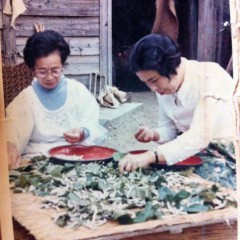以前に書いた様に、亀清旅館の「紬」テーマの部屋にお泊りになったお客様がお蚕さん関係の飾りを見て、「懐かしい!私は昔、鑑別師だった」と言うエピソードがありました。それまで、お蚕のオスとメスを分ける専門職業の存在が知らなかった。
その方がもう一度お泊りになりました。夕食の時に私が挨拶しに行ったら、そのおばさんが私を呼んで、「この前、鑑別師のお話をしたでしょう?あなたは興味がありそうだったから、そのころからの写真を持って来た。鑑別はこういう作業だよ」と、見せてくれました。
1972年の写真。私が2歳のころ。
大学の頃(専門は国際学部だった)、私は日本の江戸から明治にわたる時代を研究しました。シルクの生産の事が良く出ました。
そして、長野に引っ越ししたら、上田紬や周辺の力石を稲荷山地区の独特な作りの昔にお蚕を育っていた古民家を見て、なお日本のシルク文化を感じました。
その文化の記念で、亀清の一つな客室を紬テーマで少し改造した訳です。
そのお蔭で、こうやって私にとっては「生きている歴史」の鑑別師との出会いが出来、とっても有難い事。
As I previously mentioned, we had the honor of hosting a lady who used to be a kanbetsu-shi. That's the profession where you separate boy silk worm grubs from the girl grubs. Before I met that lady, I'd never known such a profession existed.
The same guest came again, and when I paid a visit to their evening banquet, she pulled me to the side to show me a photograph. "You seemed interested in 'kanbetsu' -- here's an old photo from my kanbetsu days."
The photo was from 1972. I was only 2 years old then.
When I was in college (my major was International Studies), I researched about Japan's transition from Edo to Meiji eras. Silk production often came up. Then when I moved to Nagano, I was introduced to the Ueda Tsumugi silk weaving tradition and became familiar with seeing the old houses with the unique rooflines where silk worms used to be grown.
This further deepened my appreciation for Japan's silk culture.
In honor of that culture, I did a slight remake of one of our guestrooms based around a 'tsumugi' (silk weaving) theme. That brought me into contact with this veteran kanbetsu-shi. I feel honored to have been able to meet what I regard a person of 'living history'.




